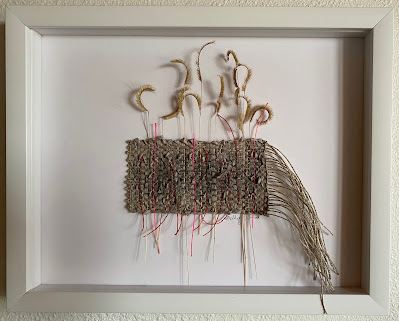It was great fun to participate in a panel discussion last week hosted by Handweavers Guild of America as part of Spinning and Weaving Week. Hosted by Julia Blake, Patsy Zawistoski and Tegan Frisino and I talked online about those weaving and spinning myths that get handed down through the generations and that ain't necessarily true. We discussed how some myths are really just rules that are helpful for beginning spinners and weavers, and that once you get some experience working within the rules, you can understand how to break them effectively. We talked about how some myths might start as just one person, maybe a teacher's, preferred way of doing things (warping back to front or vice-versa), and that as with most things, there is usually more than one "right" way to do something. I held forth about how you don't have to weave tapestry on a cotton seine twine warp, or even weave over already-woven warps, or avoid linen warps, or conform to the tapestry traditions that dictate a certain size, shape, or theme for a piece to be a tapestry. You can find the recording HERE if you were a registered attendee.
One question Julia posed stumped me: Are there any myths you can think of that are actually true? Rules you maybe shouldn't break? After the program was over, I had a few thoughts.
For the best results in tapestry, in which the weft yarns are beaten down firmly between rather widely spaced warps to make a weft-faced fabric, tightly spun, non-stretchy yarns for weaving really are better than yarns made for knitting or crochet. You simply need a sturdy, non-fluffy yarn to fill those spaces between the warps, a yarn that won't stretch as you bubble it in or pack down so much that you feel like it takes you forever to weave a half-inch. Rebecca Mezoff has written knowledgeably and extensively on this topic, and I refer you to her discussions if you're not convinced. Yes, this means you usually have to mail order your tapestry yarns rather than popping down to the local yarn store and fondling the goods in person. Take comfort in knowing that online stores can often stock far more options than a local brick-and-mortar place.
Does this mean you have to stick with wool? Not at all! Silk, linen, cotton, and more exotic fibers like stainless steel, hemp, paper and kudzu are all possibilities. They each pose particular challenges in handling that require some practice and experimentation. And then there are the found objects and upcycled materials . . . dried grasses and strips of plastic are two materials I'm playing with right now. Really, the sky is the limit on wefts as long as you are willing to experiment.
 |
| Woven sample of various blue yarns in my stash: cotton, linen, paper, Churro, soysilk and linen, on linen warp, 8 epi |
 |
| Molly Elkind, WUI 4: ashen. Linen warp, paper, plastic survey whiskers, blue grama grass wefts, rubbed with ashes |
 |
| Detail, Molly Elkind, WUI 4: ashen. Linen warp, paper, plastic survey whiskers, blue grama grass wefts, rubbed with ashes |
Another thought that occurred to me is that tension is always important. Adequate and consistent warp tension make your weaving easier and yield a more consistent woven surface. I re-learned this lesson recently when weaving with a wire warp. The wire was springy and bendy and just wouldn't stay lined up nicely and in place, especially as I was finger-picking on a loom without heddles or a shedding device. I worked around it, but it wasn't fun. Next time, I'll use a Mirrix.
 |
| Molly Elkind, Bivium study. Wire warp, wool and linen wefts, survey whisker bundles. |
Consistent weft tension is also important. Finding that sweet spot where you bubble enough to cover the warps comfortably with the just the right amount of weft takes practice. Too little weft, too little bubbling, and your whole piece starts to draw in. Too much slack in your weft makes little blips and bulges on the woven surface. Sloppy, loose turns on warps can not only look bad but also push the selvedges out as they add just that little bit of extra bulk across the width of the tapestry. Ask me how I know. . .
Indeed, when you think about it, in every fiber art tension is a factor--in crochet, in using a sewing machine, in embroidery, just to name a few--how you hold the needle or hook and pull the thread makes all the difference in the look of the finished piece. Controlling tension is key. (And that goes for the fiber practitioner too!)
My last thought on this topic is that basic principles of good design are not myths. Contrast is always important--contrast of value, color, shape, scale, line--this is what lends a piece visual excitement and interest. (Even monochromatic pieces contrast with their environment, making an impact that way.) Some contemporary artists might disagree, but I'd also say that unity, or at least coherence, is a key principle of successful design. As a viewer, I want to sense that a piece is thoughtfully put together and not a random conglomeration of materials and techniques.
 |
| Molly Elkind, Peachtree Boogie Woogie, collaged tapestry in three layered pieces. Cotton warp, wool, linen, metallic wefts. |
If you're interested in knowing more about the essentials of good design for tapestry, check out the online class I'm offering next month through MAFA Virtual. Open to all who have a minimal background in tapestry weaving, it's all about the nine key principles and strategies for designing tapestry that I've discovered over the years.
